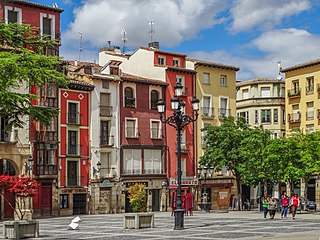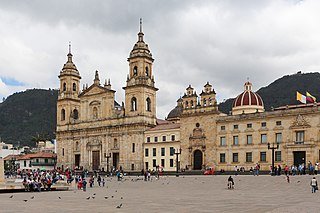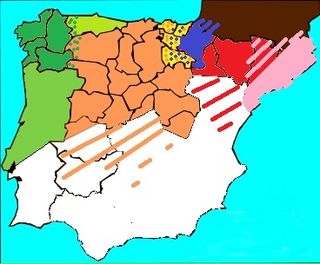
Segovia is a city in the autonomous community of Castile and León, Spain. It is the capital and most populated municipality of the Province of Segovia. Segovia is in the Inner Plateau, near the northern slopes of the Sistema Central range and on a bend of the Eresma river.

Morelia is a city and municipal seat of the municipality of Morelia in the north-central part of the state of Michoacán in central Mexico. The city is in the Guayangareo Valley and is the capital and largest city of the state. The main pre-Hispanic cultures here were the Purépecha and the Matlatzinca, but no major cities were founded in the valley during this time. The Spanish took control of the area in the 1520s. The Spanish under Viceroy Antonio de Mendoza founded a settlement here in 1541 with the name of Valladolid, which became rival to the nearby city of Pátzcuaro for dominance in Michoacán. In 1580, this rivalry ended in Valladolid's favor, and it became the capital of the viceregal province. After the Mexican War of Independence, the city was renamed Morelia in honor of José María Morelos, who hailed from the city. In 1991, the city was declared a UNESCO World Heritage Site for its well-preserved historical buildings and layout of the historic center. It is tradition to name people born on September 30 after the city.

Logroño is the capital of the autonomous community of La Rioja, Spain. Located in the north of the Iberian Peninsula, primarily in the right (South) bank of the Ebro River, Logroño has historically been a place of passage, such as the Camino de Santiago. Its borders were disputed between the Iberian kingdoms of Castille, Navarre and Aragon during the Middle Ages.

Coyoacán is a borough in Mexico City. The former village is now the borough's "historic center". The name comes from Nahuatl and most likely means "place of coyotes", when the Aztecs named a pre-Hispanic village on the southern shore of Lake Texcoco dominated by the Tepanec people. Against Aztec domination, these people allied with the Spanish, who used the area as a headquarters during the Spanish conquest of the Aztec Empire and made it the first capital of New Spain between 1521 and 1523.

Old San Juan is a historic district located at the "northwest triangle" of the islet of San Juan in San Juan. Its area roughly correlates to the Ballajá, Catedral, Marina, Mercado, San Cristóbal, and San Francisco sub-barrios (sub-districts) of barrio San Juan Antiguo in the municipality of San Juan, Puerto Rico.

The Gran Vía is a street in central Madrid, Spain. It leads from Calle de Alcalá, close to Plaza de Cibeles, to Plaza de España. The street, sometimes referred to as the "Spanish Broadway", is one of the city's most important shopping areas, with a large number of hotels and large movie theatres. However, since the late 2000s, many of these theatres have been replaced by shopping centres.

The Bolívar Square is the main square of the Colombian capital Bogotá. The square, previously called Plaza Mayor until 1821 and Plaza de la Constitución, is located in the heart of the historical area of the city and hosts a statue of Simón Bolívar, sculpted in 1846 by the Italian Pietro Tenerani, which was the first public monument in the city.

The Plaza Mayor is a major public space in the heart of Madrid, the capital of Spain. It was once the centre of Old Madrid. It was first built (1580–1619) during the reign of Philip III. Only a few blocks away is another famous plaza, the Puerta del Sol.

The Metropolitan and Primate Cathedral Basilica of the Immaculate Conception and Saint Peter of Bogotá or better known as the Metropolitan Cathedral Basilica of Bogotá and Primate of Colombia, officially Sacred Holy Temple Metropolitan Cathedral Basilica and Primate of the Immaculate Conception of Mary and Saint Peter, is a cathedral church of Catholic worship consecrated to the Immaculate Conception and under the patronage of Saint Peter; it is a Neoclassical style building located in the Plaza de Bolívar in Bogotá, the country's capital.

Ciudad Colonial is the historic central neighborhood of the Dominican Republic's capital Santo Domingo. It is the oldest continuously inhabited European-established settlement in the Americas. The area has been declared a World Heritage Site by UNESCO. It is also known as Zona Colonial or more colloquially as "La Zona".

The Metropolitan Archdiocese of Valladolid is a Latin Church diocese of the Catholic Church in Spain, elevated from the rank of diocese in 1857.

The Cathedral of Our Lady of the Assumption and of Saint Fructus is a Roman Catholic cathedral located in the Spanish city of Segovia. The church is dedicated to the Assumption of the Virgin Mary and to Saint Fructus and is the seat of the Diocese of Segovia. It was built in the Flamboyant style, and was dedicated in 1768, constituting one of the latest Gothic cathedrals in Europe.

The Cathedral of Our Lady of the Holy Assumption, better known as Valladolid Cathedral, is a Catholic church in Valladolid, Spain. The main layout was designed by Juan de Herrera in a Renaissance-style.

Juan de la Cuesta (?-1627) was a Spanish printer known for printing the first editions of Don Quixote de la Mancha (1605) and the Novelas ejemplares (1613), by Miguel de Cervantes, as well as the works of other leading figures of Spain's Golden Age, such as Lope de Vega.
The following is a timeline of the history of the city of Ponce, Puerto Rico.

Spanish Romanesque designates the Romanesque art developed in the Hispanic-Christian kingdoms of the Iberian Peninsula in the 11th and 12th centuries. Its stylistic features are essentially common to the European Romanesque although it developed particular characteristics in the different regions of the peninsula. There is no Romanesque art in the southern half of the peninsula because it remained under Muslim rule (Al-Andalus). The examples of Romanesque buildings in the central area of the peninsula are sparse and of the latest period, with virtually no presence south of the Ebro and the Tagus. Most Romanesque buildings can be found in the northern third of the peninsula. Romanesque art was introduced into the peninsula from east to west, so scholars have usually defined regional characteristics accordingly: the "eastern kingdoms" comprising the Pyrenean areas, Catalan Romanesque, Aragonese Romanesque and Navarrese Romanesque, and the "western kingdoms" comprising Castilian-Leonese Romanesque, Asturian Romanesque, Galician Romanesque and Portuguese Romanesque.

The Walls of Madrid are the five successive sets of walls that surrounded the city of Madrid from the Middle Ages until the end of the 19th century. Some of the walls had a defensive or military function, while others made it easy to tax goods entering the city. Towards the end of the 19th century the demographic explosion that came with the Industrial Revolution prompted urban expansion throughout Spain. Older walls were torn down to enable the expansion of the city under the grid plan of Carlos María de Castro.

The Cathedral of the Redeemer is a Protestant (Anglican) church in Madrid. It is the principal church of the Reformed Episcopal Church of Spain which is a member of the Anglican Communion.
Dragon Rapide is a 1986 Spanish historical drama film directed, written and produced by Jaime Camino, and starring Juan Diego, Vicky Peña and Manuel de Blas. It is composed by Xavier Montsalvatge. It is about the Spanish Civil War.

Luis Antonio Sanguino de Pascual is a Spanish sculptor who is known for many monumental works, mostly in bronze, both in Spain and in the Americas. After living abroad more than once, including sojourns in other European countries as a child, arising from the Spanish Civil War's upheavals, and periods during his adult life in the United States and Mexico, he currently lives near Segovia in the land of his birth.






















